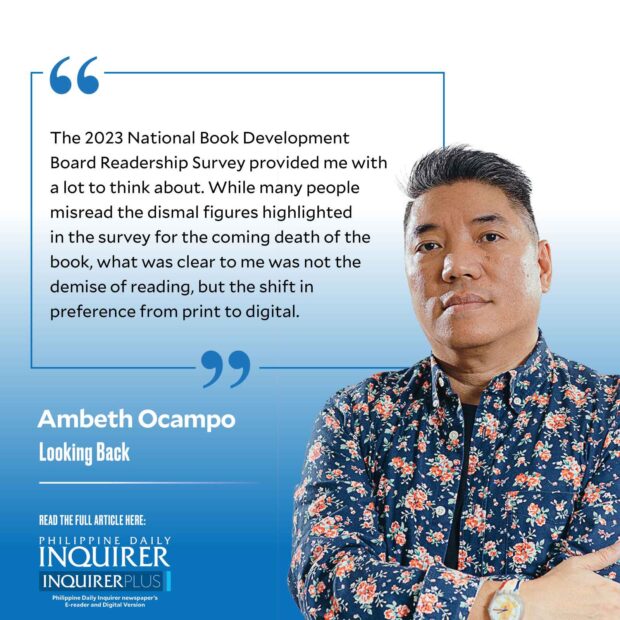Why Filipinos don’t read

All the nostalgia over books and reading generated by my last column on books and readership required a second column. Over the years, I have learned that it is not enough to write and publish books. Authors today have to market their books. Gone are the days when authors just sat to wait for reviews and royalties. Currently, one needs a social media presence and physical appearances at events to talk books and sign them. To complicate matters, it is not enough to sign and dedicate books, these days one is required to smile enthusiastically for selfies. One shot is not enough as some people want selfies taken in portrait, landscape, and even the 0.5 setting preferred by Gen Z. At my Ayala Museum lectures, the talk takes about 40 minutes, followed by at least two hours of book signing and selfies. I don’t complain as it is a good “problem” to have. In my case, work doubles because I have a mascot, a little Sigmund Freud doll, who now requires a social media account of his own because he is often more famous than me.
I would like to think that aside from the exposure that the Inquirer has given me for almost four decades now, first in print and now online, much of my readership has been helped by Facebook, Instagram, and YouTube. No TikTok yet until I have learned to dance better than Harry Roque. Facebook analytics helped me know my readers: age, gender, location, etc. culled from over 240,000 followers which makes the picture more reliable than a commissioned survey of a few hundred respondents. With this data, I convinced my publisher to print small, nonthreatening, history books that hopefully get readers interested enough to read serious or academic history. Our price range started below P100 and we made up through volume. Book covers were hip with bold colors that screamed from a bookstore shelf, “Buy me!” My byline is bigger than the title because I was advised early on that the product is “Ambeth Ocampo,” the book is just a vehicle.
The 2023 National Book Development Board Readership Survey provided me with a lot to think about. While many people misread the dismal figures highlighted in the survey for the coming death of the book, what was clear to me was not the demise of reading, but the shift in preference from print to digital. Seventy-three percent of adults said they were internet users, meaning they go online to access the internet and receive email; 98 percent used Facebook daily, 46 percent YouTube, 33 percent TikTok, 17 percent Instagram, 8 percent Viber, 7 percent X, with some people on multiple sites.
Much of what they read does not come from online books, newspapers, and magazines. Much of what is read today is delivered by social media. Seventy percent of adults had a device: Android phone (67.6 percent), laptop (2.4 percent), iPhone (1.9 percent), desktop (1.3 percent), and no device (21 percent). None of these devices are good for long-form reading that we do in print.
Children, on the other hand, start early. Just look around at families in restaurants and you will see that the new “yaya” is the smartphone that keeps toddlers quiet and eating. Seventy-seven percent of children surveyed were internet users: 92 percent used Facebook, 68 percent TikTok, 53 percent YouTube, 27 percent Instagram, 10 percent X, and 2 percent Viber. As none of these sites are text-heavy, the preference is for pictures or videos. Android phones are the most used devices for reading (95.3 percent for adults and 94.5 percent for children) and Android tablets were preferred to iPads surely because of cost.
When asked why they were not reading, 38 percent of both adults and children surveyed said that other “leisure activities were more interesting to them.” This means that, like penance, books are usually read for school and were not even remotely considered a leisure activity. Others excused themselves by claiming they couldn’t find time to read. That’s another way of saying they won’t make time for reading. Other excuses were that they couldn’t find books with interesting topics or worse, the words in books were not familiar. When asked what would make them read more, respondents said books should have words that were familiar or easy to understand (that’s a problem of comprehension, not literacy), books should have pictures not just text, topics should be interesting, or endorsed by celebrities or influencers.
One of the distressing findings of the Readership Survey is that 82 percent of adults and 88 percent of children were not aware public libraries exist. And of those aware of public libraries only 51 percent of adults and 60 percent of children have actually visited it by walking, taking a car, motorcycle, bicycle, or even a banca! Seventy-eight percent of adults and 87 percent of children who didn’t know about public libraries at least knew of school libraries. Excuses for not visiting public libraries were being too busy or having no time, having no reason to visit, the library is far from home, not fond of reading books, information being available online, and feeling too old to visit a library.
Readership is a classic chicken or egg situation. I want to be positive and think that we are not seeing a decline in reading, but rather issues with accessibility. If we have more books readily available perhaps the numbers will improve.
—————–
Comments are welcome at aocampo@ateneo.edu




















